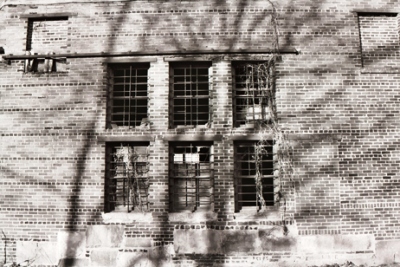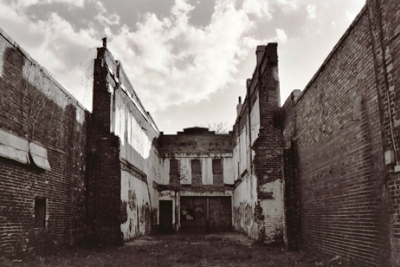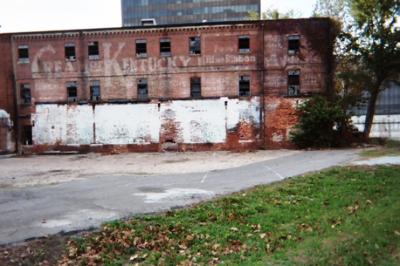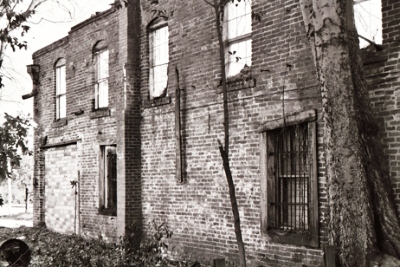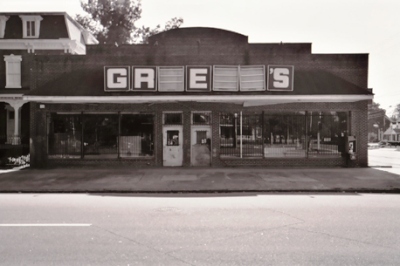
Greene St. is parallel to Broad St., just a bit south, and a street or two north of Telfair St. It's a pretty busy thoroughfare and there's plenty of lawyer's offices and businesses to the west. However, as you go east, business slacks off, although there are nice homes along most of Greene St.
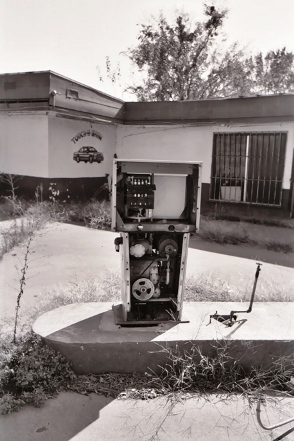 By the time you get to the end of Greene St., where it "T's" into East Boundary Rd., there's not much going on. Random historical fact: The de Laigle House, on the western side of Greene St., is where the final person to be killed in a duel in GA died. Charles Tilly died a day after defending the honor of the young Mary de Laigle at Sand Bar Ferry, right off the river on the SC border. Apparently Sand Bar Ferry was a major duelling ground, but this one, just before Christmas in 1875, was the last. Charles Tilly is said to haunt the house, which looks like the Addam's Family home.
By the time you get to the end of Greene St., where it "T's" into East Boundary Rd., there's not much going on. Random historical fact: The de Laigle House, on the western side of Greene St., is where the final person to be killed in a duel in GA died. Charles Tilly died a day after defending the honor of the young Mary de Laigle at Sand Bar Ferry, right off the river on the SC border. Apparently Sand Bar Ferry was a major duelling ground, but this one, just before Christmas in 1875, was the last. Charles Tilly is said to haunt the house, which looks like the Addam's Family home.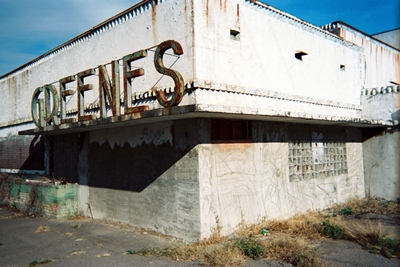
I always wanted to make it into this old night club, but the concrete was a bit of an impediment. Once, while staying in the cheapest motel in Savannah (The Thunderbird, right across from the Greyhound Station, natch), I got into a conversation with the desk clerk, who had briefly lived in Augusta during the 1950's. He told me about seeing Dinah Washington perform at a club and then dancing with her, as she came out front to mingle with the patrons. That dance had really made his night. I've never figured out exactly where the club was, but it seems it might have been near where the post office is now, somewhere off of 8th or 9th St.
Back on the east end of Greene St. is this Widow's Home. It's empty, but the inside was refurbished at some point with plush carpets and new paint. I don't know if anyone will ever use it again, but it's not really worth exploring. The outside looks good though. Just the ambience for widow's, I guess.
The Sacred Heart Cathedral, right where Greene St. exits onto the John Calhoun Parkway, opened in 1900 and held its last mass in 1971. After that it quickly fell into disrepair. Luckily, it was restored and is now a cultural center. So, no, it's not abandoned, but for a small donation you can wander around in the middle of the day and pretend it is. There are some great historical photos of Augusta during floods where you can see water rising along the bottom of the church. The cathedral is the only recognizable feature still around from those old photos.
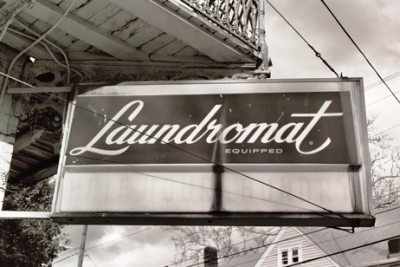
At the corner of Greene St. and 5th is this old laundromat with apartments above it. It's worth taking a closer look at this old building. So, we'll do just that next time.
Also, I realize this blog is getting pretty picture-heavy, which might make it load slow. I've reduced the number of posts on the main page to 5 and might go to 3. You can always go to the archives to see the old posts.
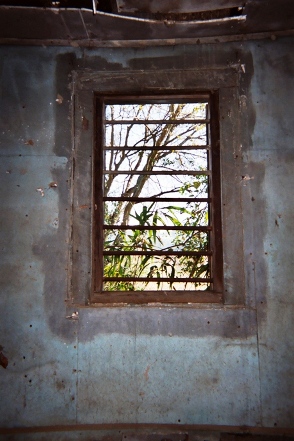 Okay, part two of Augusta's Phinizy Swamp. Right as you leave Lover's Lane and head into the swamp you come across a small old house on the corner. Actually, if it's summer you probably won't see it as it completely disappears into the vegetation. It takes some work to get into even in the best of circumstances since you have to cross a ditch that's sometimes full of water, snakes, bones, etc. But, once you get inside you're in what was probably a pretty cozy little farm pad. There's a brick fireplace and the walls are all painted this dark blue. This photo is of the view out the back.
Okay, part two of Augusta's Phinizy Swamp. Right as you leave Lover's Lane and head into the swamp you come across a small old house on the corner. Actually, if it's summer you probably won't see it as it completely disappears into the vegetation. It takes some work to get into even in the best of circumstances since you have to cross a ditch that's sometimes full of water, snakes, bones, etc. But, once you get inside you're in what was probably a pretty cozy little farm pad. There's a brick fireplace and the walls are all painted this dark blue. This photo is of the view out the back.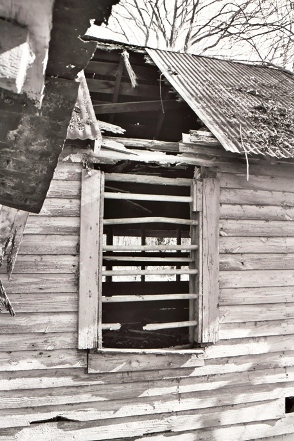 has probably had chiggers, which leave little red, swollen bumps. My worst episode left me with about 50 bites and three sleepless nights. Afterwards, I found out that the best way to get rid of chiggers is simply to wipe yourself down with a towel after you've been in a potentially chigger-infested area. Apparently there's about a 1-2 hour window before they actually bite you. That was great to read as I was desperately trying not to scratch the things. Problem is, it feels REALLY good to scratch 'em. As an associate of mine said, scratching them is "equisite." I'm afraid it's true, and once you start you can't stop.
has probably had chiggers, which leave little red, swollen bumps. My worst episode left me with about 50 bites and three sleepless nights. Afterwards, I found out that the best way to get rid of chiggers is simply to wipe yourself down with a towel after you've been in a potentially chigger-infested area. Apparently there's about a 1-2 hour window before they actually bite you. That was great to read as I was desperately trying not to scratch the things. Problem is, it feels REALLY good to scratch 'em. As an associate of mine said, scratching them is "equisite." I'm afraid it's true, and once you start you can't stop.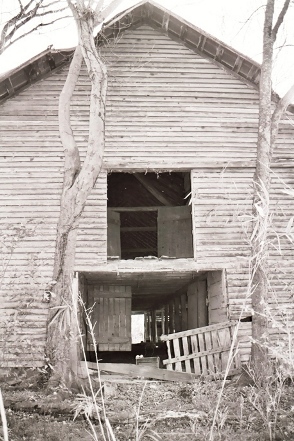 Just adjacent to the farmhouse is this massive barn. The swamp is fast reclaiming the land that isn't being actively bulldozed and it's hard to imagine someone trying to farm, let alone graze cows or ride horses, anywhere around this barn. Around the side, if I had a shot of it, you could see the massive trees that are slowly crushing the eves along the roof, a testament to how old the barn really is.
Just adjacent to the farmhouse is this massive barn. The swamp is fast reclaiming the land that isn't being actively bulldozed and it's hard to imagine someone trying to farm, let alone graze cows or ride horses, anywhere around this barn. Around the side, if I had a shot of it, you could see the massive trees that are slowly crushing the eves along the roof, a testament to how old the barn really is.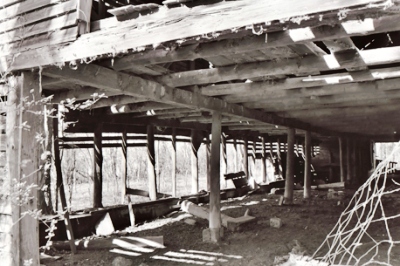
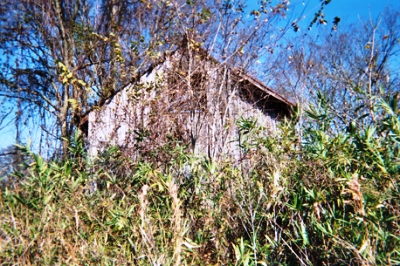
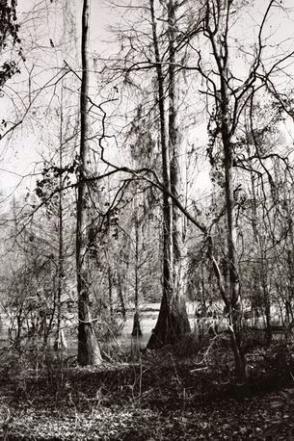 (that's Taxodium distichum L. if you're into scientific nomenclature). The most intact remnant is partitioned off as the Phinizy Swamp Nature Center and has trails, an interpretive center, and nature programs. You can find more information about the nature center
(that's Taxodium distichum L. if you're into scientific nomenclature). The most intact remnant is partitioned off as the Phinizy Swamp Nature Center and has trails, an interpretive center, and nature programs. You can find more information about the nature center 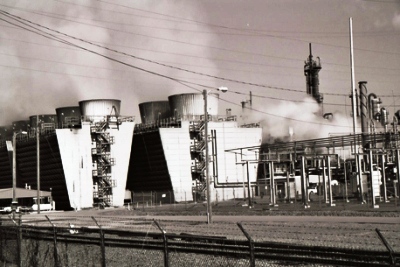
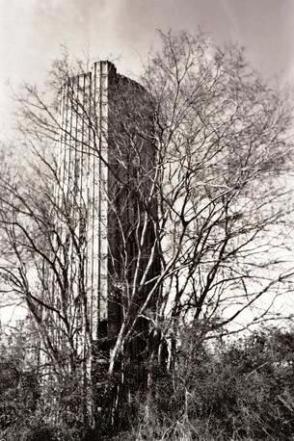 The periphery of the swamp (and maybe a large part of the swamp itself) is/was farmland. Some of the land looks to be abandoned and chunks have been reclaimed by mother nature. On a few tracts just beyond the swamp you might see a lonely tractor tooling around and, cutting through one section, there is what appears to be serious road construction. I don't know what the plans are or if the construction will be the death knell of a large part of the swamp, but I can tell you that the work isn't moving very fast.
The periphery of the swamp (and maybe a large part of the swamp itself) is/was farmland. Some of the land looks to be abandoned and chunks have been reclaimed by mother nature. On a few tracts just beyond the swamp you might see a lonely tractor tooling around and, cutting through one section, there is what appears to be serious road construction. I don't know what the plans are or if the construction will be the death knell of a large part of the swamp, but I can tell you that the work isn't moving very fast.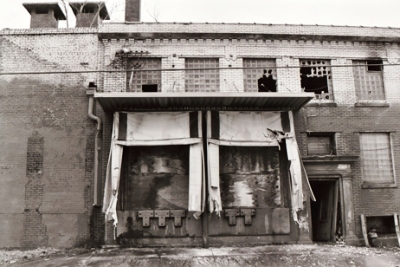
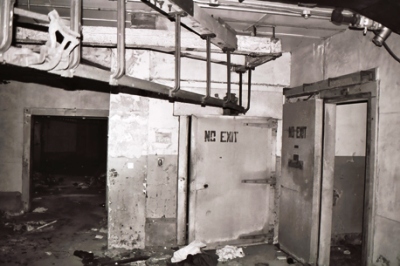
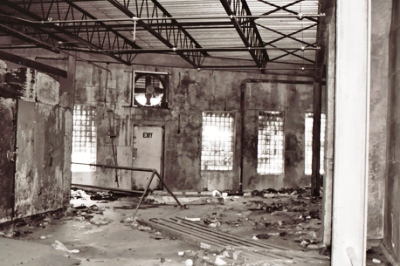
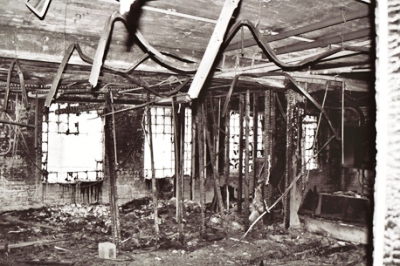
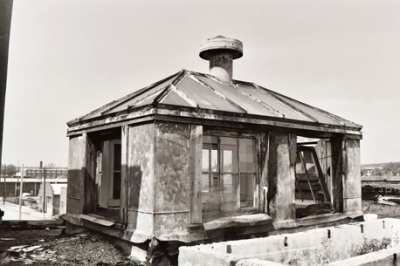
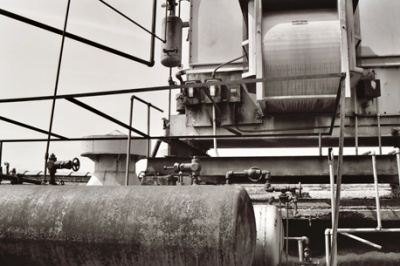
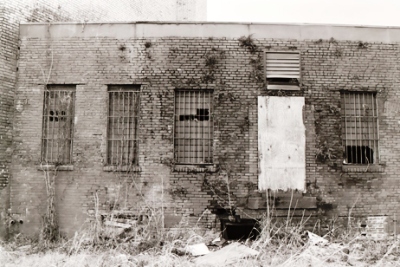
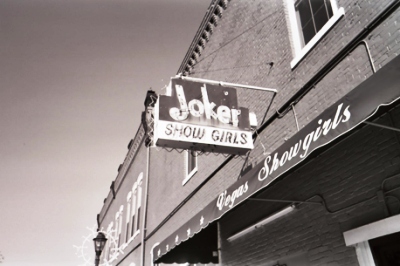

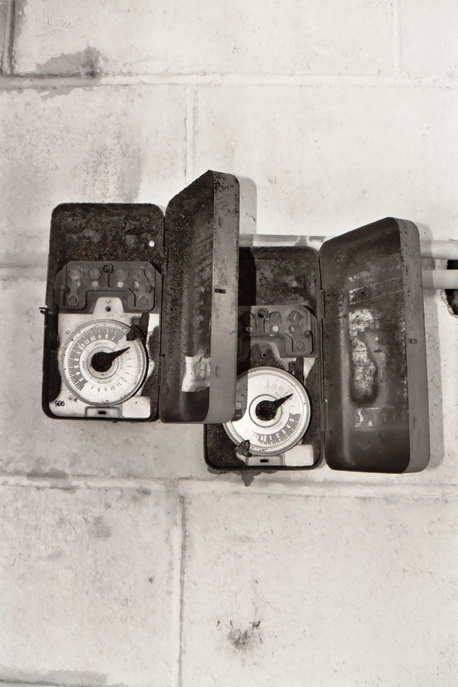 Also in front of this lot is the Miller Theater (a great looking movie theater that I'll get to later) so maybe theatergoers parked here before seeing a film. In any case, it's been awhile since these timers have been used to stamp any tickets.
Also in front of this lot is the Miller Theater (a great looking movie theater that I'll get to later) so maybe theatergoers parked here before seeing a film. In any case, it's been awhile since these timers have been used to stamp any tickets.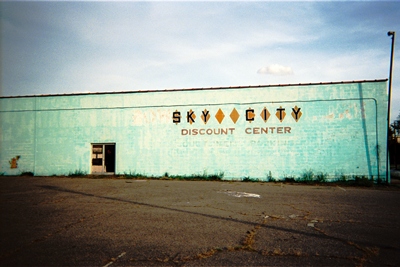
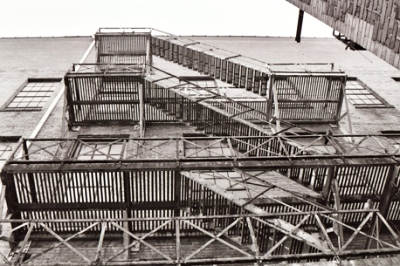 Lots of these old buildings have rickety fire escapes. I've never tried climbing up one since I've got pretty poor health insurance, but they always looked inviting. This one is just down an alley and monitored by video surveillance for some reason. Maybe the pigeons are plotting something.
Lots of these old buildings have rickety fire escapes. I've never tried climbing up one since I've got pretty poor health insurance, but they always looked inviting. This one is just down an alley and monitored by video surveillance for some reason. Maybe the pigeons are plotting something.  This fire escape is behind the former J. B. White's Department store. Not shown is the neat skyway running across the street from White's a couple stories up. Apparently this is one of the only parts of the building to actually be fully restored as it was being prepared for condos. Interesting choice, since the skyway appears to go into another empty building. These days you don't see many buildings decorated with those little square tiles people used to put in their bathtubs, but all that blue and white along the bottom of the building is just that. They probably had sheets of the things to make installation easy, but I prefer to picture some guy sticking each one on by hand.
This fire escape is behind the former J. B. White's Department store. Not shown is the neat skyway running across the street from White's a couple stories up. Apparently this is one of the only parts of the building to actually be fully restored as it was being prepared for condos. Interesting choice, since the skyway appears to go into another empty building. These days you don't see many buildings decorated with those little square tiles people used to put in their bathtubs, but all that blue and white along the bottom of the building is just that. They probably had sheets of the things to make installation easy, but I prefer to picture some guy sticking each one on by hand.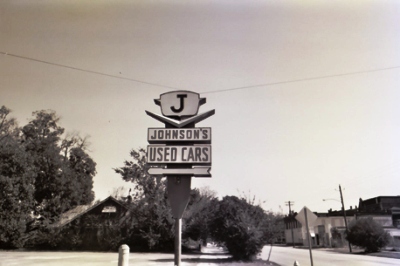
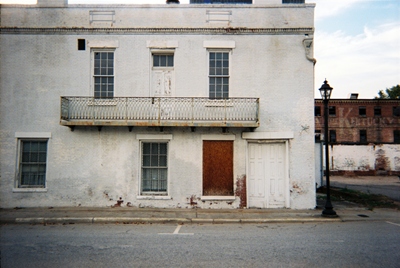
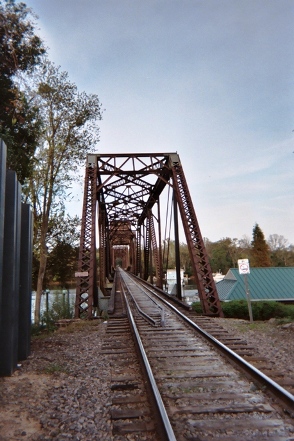 munitions to the Confederate army than any other city. The construction of the Augusta Canal later ensured that the city became a center of industry when it could have been forgotten as the agrarian way of life died a slow and painful death. Following years of tobacco and then cotton cultivation, both crops that strip the soil, farmers were being forced to abandon their land and the city's prospects might have been dim. But the canal provided access to and from the Savannah River, not to mention power, creating just the right environment for textile mills to spring up throughout the city and greasing the wheels of venture capitalism. I'll get into the canal and the mills of nearby Horse Creek Valley later.
munitions to the Confederate army than any other city. The construction of the Augusta Canal later ensured that the city became a center of industry when it could have been forgotten as the agrarian way of life died a slow and painful death. Following years of tobacco and then cotton cultivation, both crops that strip the soil, farmers were being forced to abandon their land and the city's prospects might have been dim. But the canal provided access to and from the Savannah River, not to mention power, creating just the right environment for textile mills to spring up throughout the city and greasing the wheels of venture capitalism. I'll get into the canal and the mills of nearby Horse Creek Valley later.